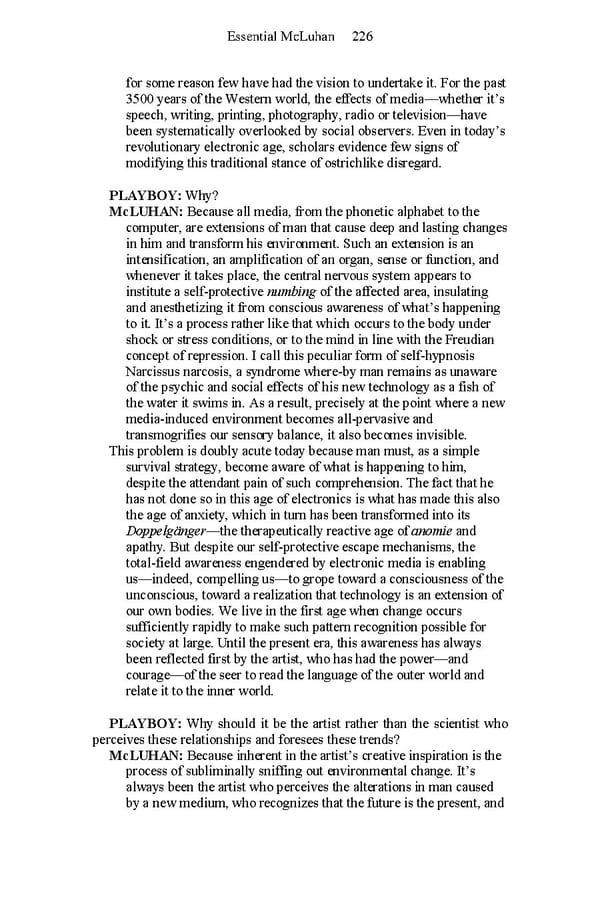Essential McLuhan 226 for some reason few have had the vision to undertake it. For the past 3500 years of the Western world, the effects of media—whether it’s speech, writing, printing, photography, radio or television—have been systematically overlooked by social observers. Even in today’s revolutionary electronic age, scholars evidence few signs of modifying this traditional stance of ostrichlike disregard. PLAYBOY: Why? McLUHAN: Because all media, from the phonetic alphabet to the computer, are extensions of man that cause deep and lasting changes in him and transform his environment. Such an extension is an intensification, an amplification of an organ, sense or function, and whenever it takes place, the central nervous system appears to institute a self-protective numbing of the affected area, insulating and anesthetizing it from conscious awareness of what’s happening to it. It’s a process rather like that which occurs to the body under shock or stress conditions, or to the mind in line with the Freudian concept of repression. I call this peculiar form of self-hypnosis Narcissus narcosis, a syndrome where-by man remains as unaware of the psychic and social effects of his new technology as a fish of the water it swims in. As a result, precisely at the point where a new media-induced environment becomes all-pervasive and transmogrifies our sensory balance, it also becomes invisible. This problem is doubly acute today because man must, as a simple survival strategy, become aware of what is happening to him, despite the attendant pain of such comprehension. The fact that he has not done so in this age of electronics is what has made this also the age of anxiety, which in turn has been transformed into its Doppelgänger—the therapeutically reactive age of anomie and apathy. But despite our self-protective escape mechanisms, the total-field awareness engendered by electronic media is enabling us—indeed, compelling us—to grope toward a consciousness of the unconscious, toward a realization that technology is an extension of our own bodies. We live in the first age when change occurs sufficiently rapidly to make such pattern recognition possible for society at large. Until the present era, this awareness has always been reflected first by the artist, who has had the power—and courage—of the seer to read the language of the outer world and relate it to the inner world. PLAYBOY: Why should it be the artist rather than the scientist who perceives these relationships and foresees these trends? McLUHAN: Because inherent in the artist’s creative inspiration is the process of subliminally sniffing out environmental change. It’s always been the artist who perceives the alterations in man caused by a new medium, who recognizes that the future is the present, and
 Essential McLuhan Page 232 Page 234
Essential McLuhan Page 232 Page 234